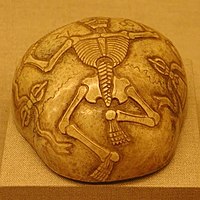Kapala
A kapala (Sanskrit for "skull") or skullcup is a cup made from a human skull used as a ritual implement (bowl) in both Hindu Tantra and Buddhist Tantra (Vajrayana). Especially in Tibet, they were often carved or elaborately mounted with precious metals and jewels.


Nomenclature, orthography & etymology
'Kapala' (Tibetan: ཀ་པ་ལ, Wylie: kapala) is a loan word into Tibetan from Sanskrit 'kapāla' (Devanagari: कपाल) and it denotes the 'skull' or 'forehead' (most often of the human) and by implication the ritual item, the skullcup, crafted from the human cranium.
Vajrayana deities

Many of the deities of Vajrayana, including Mahasiddhas, Dakinis and Dharmapalas are depicted as carrying the kapala, usually in their left hand. Some deities such as the Hindu Chinnamasta and the related Buddhist Vajrayogini are depicted as drinking blood from the Kapala.[1]
Hindu deities
Hindu deities that may be depicted with the kapala include Durga, Kālī and Shiva, especially in his Bhairava form. Even Ganesha, when adopted into Tibetan Buddhism as Maharakta Ganapati, is shown with a kapala filled with blood.
Some of the Hindu deities pictured thus are:
a) Kālī, pictured in the most common four armed iconographic image shows each hand carrying variously a sword, a trishula (trident), a severed head and a bowl or skullcup (kapala) catching the blood of the severed head.
b) The Chamunda, a form of Durga, seen in Halebidu temple of Hoysala architecture, in black or red colour, is described as wearing a garland of severed heads or skulls (Mundamala). She is described as having four, eight, ten or twelve arms, holding a Damaru (drum), trishula (trident), sword, a snake (nāga), skull-mace (khatvanga), thunderbolt (vajra), a severed head and panapatra (drinking vessel, wine cup) or skullcup (kapala), filled with blood.
The Kapalikas
Uses
In Tibetan monasteries it is used symbolically to hold bread or dough cakes, torma, and wine instead of blood and flesh as offerings to wrathful deities, such as the ferocious Dharmapāla ("defender of the faith"). The dough cakes are shaped to resemble human eyes, ears and tongues. The kapala is made in the form of a skull specially collected and prepared. It is elaborately anointed and consecrated before use. The cup is also elaborately decorated and kept in a triangular pedestal. The heavily embossed cup is usually made of silver-gilt bronze with lid shaped like a skull and with a handle made in the form of a thunderbolt.[2]
Kapalas are used mainly for esoteric purposes such as rituals. Among the rituals using kapalas are: higher tantric meditation to achieve a transcendental state of thought and mind within the shortest possible time; libation to gods and deities to win their favor; by Tibetan Lamas as an offering bowl on the altar, filled with wine or blood as a gift to the Yidam Deity or all the Deities; and the Vajrayana empowerment ceremony.
Kapalas are also used to make Malas or Prayer Beads.The beads in these are in the form of flat discs, and they are cut from either 108 skulls, from 100 skulls, or just 8 skulls.

The stringing is required to be done by a Virgin girl. While Malas can be made of any material such as stones, agate, turquoise or even plastic, the most prized ones are those made from Kapalas.
Charnel ground or Sky burial
The kapala is one of several charnel ground implements made from human bone found by tantrics at sky burial sites.

Charnel ground, an ancient Tibetan burial custom, is distinctly different from the customs of graveyards and cremation, but all three of them have been a part of the home ground of tantric practitioners’ such as the yogis and yoginis, Shaiva Kapalika's and Aghoris, shamans and sadhus. The Charnel ground, interpreted as the Sky burial by the Western society, is an area demarcated specifically in Tibet, defined by the Tibetan word Jhator (literal meaning is ’giving alms to the birds’), a way of exposing the corpse to nature, where human bodies are disposed as it were or in a chopped (chopped after the rituals) condition in the open ground as a ritual that has great religious meaning of the ascent of the soul to be reincarnated into another circle of life. Such a practice results in finding human bones, half or whole skeletons, more or less putrefying corpses and disattached limbs lying scattered around. Items made from human skulls or bones are found in the sky burial grounds by the Sadhus and Yogins of the tantric cult. The charnel grounds are also known by the epithets the "field of death" or the "valley of corpses". In Tibet, a class distinction in the burial practices is also noted. The dead High Lamas are buried in Stupas or cremated but the dead commoners are disposed of in the Charnel ground or in a Sky burial.[3][4]
The products from the charnel ground are the charnel ground ornaments such as the i) Crown of five skulls, ii) Bone necklace, iii) Bone armlets, iv) Bone bracelets, v) Bone skirt and vi) Bone anklets which decorate many images of dakinis, yoginis, dharmapalas and a few other deities (as may be seen in some of the pictures and stone images depicted in the gallery here), and other products such as the Bone trumpet, the Skull cup and Skull drum used by the tantric practitioners. Kapala or the skull cup is thus a produce from the Charnel ground.[5]

Gallery
-
6 armed Mahakala – tantric protective deity with a kapala in the hand.
-
Dancing Rakta Ganapathi with Kapala in hand
-
Tibetan Rakta Ganapathi with Kapala in hand
See also
Notes
- ^ Benard, Elisabeth Anne (1994). Chinnamasta: The Aweful Buddhist and Hindu Tantric Goddess. Delhi: Motilal Barnarsidass. ISBN 81-208-1065-1
- ^ Encyclopædia Britannica. Kapala
- ^ Of Charnel Grounds, Graveyards and Cremation Grounds
- ^ Sky burial
- ^ Charnel Ground Ornaments and Implements
References
- The Yoniverse. Skull Cup



